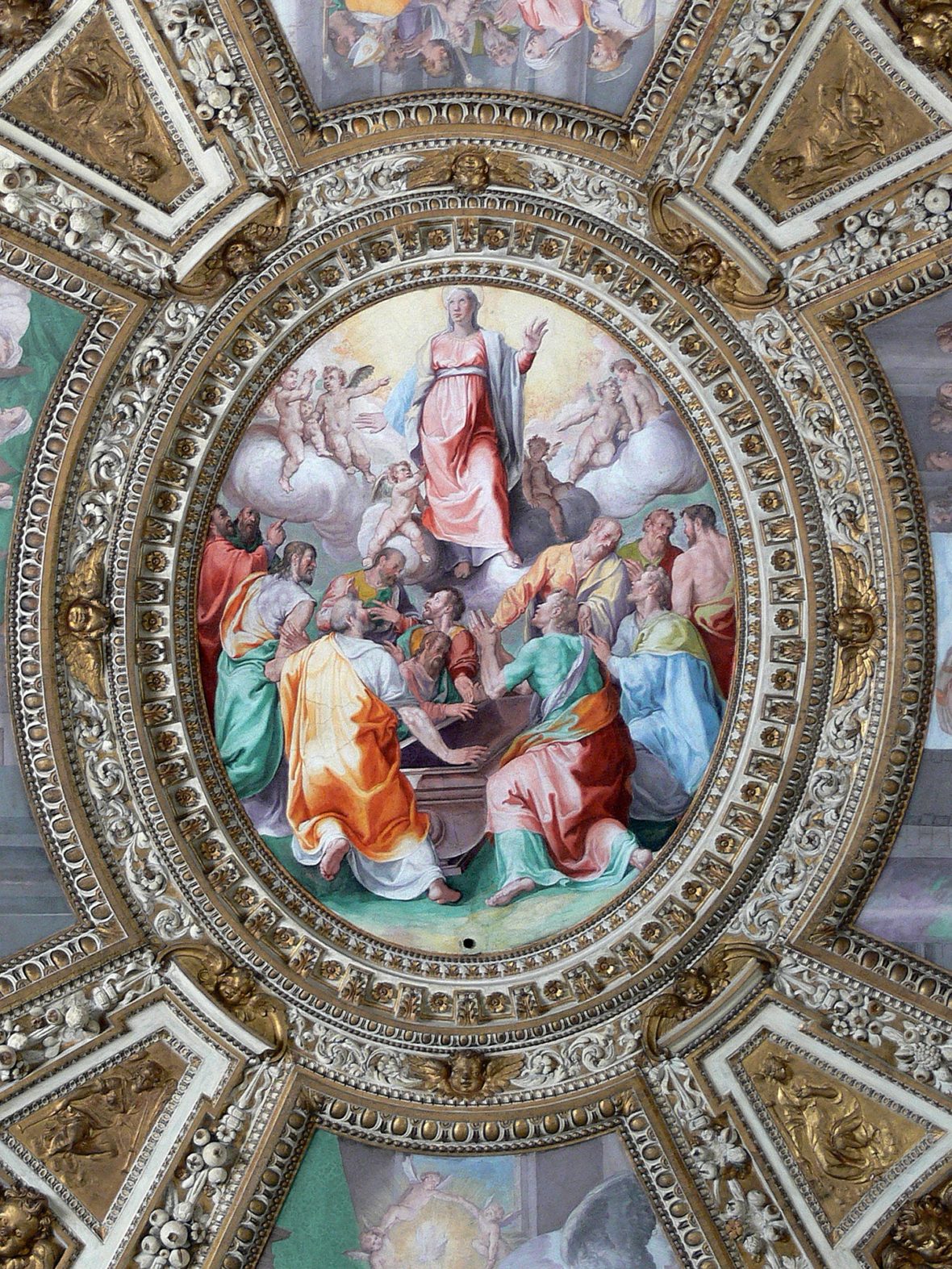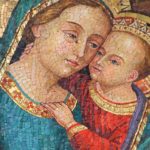Today, on the fifteenth day of August, the Catholic Church celebrates the Assumption of the Blessed Virgin Mary into Heaven; or, as it is sometimes referred, Marymass.
Mary’s life on Earth drew to a close. Her eyes were fixed on Heaven. Her heart beat with affection for God; her face shone and a smile was ever on her lips. All at once her heart gave a start, and Mary flew to Heaven, to the embrace of her beloved.
~Rev. James Alberione, S.S.P., from The Life of The Madonna in Art
The Fr. Alberione quote was all I intended to post for Marymass, but I checked to see what Dom Prosper Gueranger (b. 1805- d. 1875) had written about it, and, as usual, his writing is rich and informative; therefore, I am posting a portion of Dom Prosper for those who have a bit more reading time. Following Dom Prosper, I included a small portion of the apostolic constitution Munificentissiumus Deus (1950), wherein Pope Pius XII declared the Assumption to be a dogma of the Catholic Faith.
First, Dom Prosper wrote about the Assumption in The Liturgical Year:
Today the Virgin Mary ascended to Heaven! Rejoice, for she reigns with Christ forever.” The Church will close her chants on this glorious day with this sweet antiphon which resumes the object of the feast and the spirit in which it should be celebrated.
No other solemnity breathes like this one at once triumph and peace. None better answers to the enthusiasm of the many and the serenity of souls consummated in love. Assuredly that was as great a triumph when our Lord, rising by His own power from the tomb, cast Hell into dismay. But to our souls, so abruptly drawn from the abyss of sorrows on Golgotha, the suddenness of the victory caused a sort of stupor to mingle with the joy of that greatest of days. In presence of the prostrate Angels, the hesitating Apostles, the women seized with fear and trembling, one felt that the divine isolation of the Conqueror of death was perceptible even to his most intimate friends and kept them, like Magdalene, at a distance.
Mary’s death, however, leaves no impression but peace. That death had no other cause than love. Being a mere creature, she could not deliver herself from that claim of the old enemy, but leaving her tomb filled with flowers, she mounts up to Heaven, flowing with delights, leaning upon her Beloved (Canticles viii. 5). Amid the acclamations of the daughters of Sion who will henceforth never cease to call her blessed, she ascends surrounded by choirs of heavenly spirits joyfully praising the Son of God. Nevermore will shadows veil, as they did on Earth, the glory of the most beautiful daughter of Eve. Beyond the immovable Thrones, beyond the dazzling Cherubim, beyond the flaming Seraphim, onward she passes, delighting the heavenly city with her sweet perfumes. She stays not till she reaches the very confines of the Divinity. Close to the throne of honour where her Son, the King of ages, reigns in justice and in power. There she is proclaimed Queen, there she will reign for evermore in mercy and in goodness. Here on earth Libanus and Amana, Sanir and Hermon dispute the honour of having seen her rise to Heaven from their summits. And truly the whole world is but the pedestal of her glory, as the moon is her footstool, the sun her vesture, the stars of heaven her glittering crown. “Daughter of Sion, you are all fair and sweet,” cries the Church as in her rapture she mingles her own tender accents with the songs of triumph: “I saw the beautiful one as a dove rising up from the brooks of waters. In her garments was the most exquisite odour, and as in the days of spring, flowers of roses surrounded her and lilies of the valley” (Canticles v. 12; Ecclesiastes l. 8).
The same freshness breathes from the facts of Bible history in which the interpreters of the sacred Books see the figure of Mary’s triumph. As long as this world lasts, a severe law protects the entrance to the eternal palace. No-one, without having first laid aside the garb of flesh, is admitted to contemplate the King of Heaven. There is one, however, of our lowly race, whom the terrible decree does not touch: the true Esther, in her incredible beauty, advances without hindrance through all the doors. Full of grace, she is worthy of the love of the true Assuerus. But on the way which leads to the awful throne of the King of kings, she walks not alone: two handmaids, one supporting her steps, the other holding up the long folds of her royal robe, accompany her. They are the angelic nature and the human, both equally proud to hail her as their mistress and lady, and both sharing in her glory.
If we go back from the time of captivity when Esther saved her people, to the days of Israel’s greatness, we find our Lady’s entrance into the city of endless peace represented by the Queen of Saba coming to the earthly Jerusalem. While she contemplates with rapture the magnificence of the mighty prince of Sion, the pomp of her own retinue, the incalculable riches of the treasure she brings, her precious stones and her spices, plunge the whole city into admiration. “There was brought no more,” says the Scripture, “such abundance of spices as these which the Queen of Saba gave to King Solomon” (3 Kings x. 10).
The reception given by David’s son to Bethsabee, his mother, in the third Book of Kings, no less happily expresses the mystery of today, so replete with the filial love of the true Solomon. “Then Bethsabee came to King Solomon… and the king arose to meet her, and bowed to her, and sat down on his throne: and a throne was set for the king’s mother: and she sat on his right hand” (3 Kings ii. 19) O Lady, how exceedingly do you surpass all the servants and ministers and friends of God! “On the day when Gabriel came to my lowliness,” are the words Saint Ephrem puts into your mouth, “from handmaid I became Queen. And I, the slave of your divinity, found myself suddenly the mother of your humanity, my Lord and my Son! O Son of the King who has made me his daughter, O you heavenly One, who thus brings into Heaven this daughter of Earth, by what name shall I call you?” The Lord Christ Himself answered. The God made Man revealed to us the only name which fully expresses Him in His two-fold nature: He is called The Son. Son of Man as He is Son of God, on Earth He has only a Mother, as in Heaven He has only a Father. In the august Trinity He proceeds from the Father, remaining consubstantial with Him, only distinguished from Him in that He is Son, producing together with Him, as one Principle, the Holy Ghost. In the external mission He fulfils by the Incarnation to the glory of the Blessed Trinity, communicating to His humanity the manners, so to say, of His Divinity, as far as the diversity of the two natures permits, He is in no way separated from His Mother, and would have her participate even in the giving of the Holy Ghost to every soul. This ineffable union is the foundation of all Mary’s greatnesses, which are crowned by today’s triumph.
The days within the Octave will give us an opportunity of showing some of the consequences of this principle. Today let it suffice to have laid it down. “As Christ is the Lord,” says Arnold of Bonneval, the friend of Saint Bernard, “Mary is Lady and sovereign. He who bends the knee before the Son, kneels before the Mother. At the sound of her name the devils tremble, men rejoice, the Angels glorify God. Mary and Christ are one flesh, one mind, and one love. From the day when it was said, ‘The Lord is with thee,’ the grace was irrevocable, the unity inseparable. And in speaking of the glory of Son and Mother, we must call it not so much a common glory as the self-same glory.” “O you, the beauty and the honour of your Mother,” adds the great deacon of Edessa, “thus have you adorned her in every way. Together with others she is your sister and your bride, but she alone conceived you.” Rupert in his turn cries out: “Come then, O “most beautiful one, you will be crowned in Heaven Queen of saints, on Earth Queen of every kingdom. Wherever it will be said of the Beloved that He is crowned with glory and honour and set over the works of His Father’s hands, everywhere also will they proclaim of you, O well beloved, that you are His Mother, and as such Queen over every domain where His power extends. And therefore emperors and kings will crown you with their crowns and consecrate their palaces to you.”
Among the feasts of the Saints this is the solemnity of solemnities. “Let the mind of man,” says Saint Peter Damian, “be occupied in declaring her magnificence. Let his speech reflect her majesty. May the sovereign of the world deign to accept the good will of our lips, to aid our insufficiency, to illumine with her own light the sublimity of this day.”
It is no new thing, then, that Mary’s triumph fills the hearts of Christians with enthusiasm. Before our times the Church showed by the prescriptions kept in the Corpus juris the pre-eminence she assigned to this glorious anniversary. Thus, under Boniface VIII she granted to it, as to no other feast, except Christmas, Easter and Pentecost, the privilege of being celebrated with ringing of bells and the customary splendour in countries laid under interdict. In his instructions to the newly-converted Bulgarians, Saint Nicholas I who occupied the Apostolic See from 858 to 867, had already united these four solemnities when recommending the fasts of Lent, of the Ember days, and of the Vigils of these feasts: “Fasts,” he says, “which the holy Roman Church has long since received and observed.”…
…Let us, too, do honour to the gift of God. Let us be grateful to the Church for having given us this feast on which to sing with the Angels the glory of Mary.
“When the time came for the Blessed Mary to leave this earth, the Apostles were gathered together from all lands, and having learnt that the hour was at hand they watched with her. Now the Lord Jesus came with His Angels and received her soul. In the morning the Apostles took up her body and placed it in the tomb. And again the Lord came, and the holy body was taken up in a cloud.” To this testimony of Gregory of Tours the whole West and East respond, extolling “the solemnity of the blessed night on which the venerated Virgin made her entry into Heaven.” “What a brilliant light pierces the darkness” of this night, says Saint John Damascene. And he goes on to describe the assembly of the faithful eagerly pressing during the sacred night to hear the praises of the Mother of God.
How could Rome, so devout to Mary, allow herself to be outdone? On the testimony of Saint Peter Damian, the whole people spent the glorious night in prayer, singing and visiting the different churches. And, according to several privileged persons enlightened from above, still greater, at that blessed hour, was the number of souls delivered from Purgatory by the Queen of the universe, and all visiting likewise the sanctuaries consecrated to her name. But the most imposing of all demonstrations in the city was the memorable litany or procession, which dates back to the Pontificate of Saint Sergius (687‒701). Up to the second half of the sixteenth century it continued to express, as Rome alone knows how to, the august visit our Lady received from her Son at the solemn moment of her departure from this world.
Two principal sanctuaries in the Eternal City represent, as it were, the residences or palaces of Mother and Son: the basilica of our Saviour on the Lateran and that of Saint Mary on the Esquiline. As the latter rejoices in possessing the picture of the Blessed Virgin painted by Saint Luke, the Lateran preserves in a special oratory, holy of holies, the picture not made by hand of man representing the form of our Saviour upon cedar-wood. On the morning of the Vigil the Sovereign Pontiff, accompanied by the Cardinals, went barefoot and, after seven genuflections, uncovered the picture of the Virgin’s Son. In the evening, while the bell of Ara Coeli gave from the Capitol the signal for the preparations prescribed by the city magistrates, the Lord Pope went to Saint Mary Major, where, surrounded by his court, he celebrated First Vespers. At the beginning of the night the Matins with nine Lessons were chanted in the same church. Meanwhile an ever-growing crowd gathers on the piazza of the Lateran, awaiting the Pontiff’s return. From all sides appear the various guilds of the arts and crafts, each led by its own head and taking up its appointed position. Around the picture of the Saviour, within the sanctuary, stand the twelve bearers who form its perpetual guard, all members of the most illustrious families, and near them are the representatives of the senate and of the Roman people. But the signal is given that the papal retinue is re-descending the Esquiline. Instantly lighted torches glitter on all sides, either held in the hand, or carried on the brancards of the corporations. Assisted by the deacons, the Cardinals raise on their shoulders the holy image, which advances under a canopy, escorted in perfect order by the immense multitude. Along the illuminated and decorated streets, amid the singing of Psalms and the sound of instruments, the procession reaches the ancient Triumphal Way, winds round the Colliseum and, passing through the arches of Constantine and Titus, halts for a first Station on the Via Sacra before the church called Saint Mary Minor or Nuova. In this church, while the second Matins with three Lessons are being chanted in honour of the Mother, some priests wash, with scented water in a silver basin, the feet of her Son, our Lord, and then sprinkle the people with the water thus sanctified. Then the venerable picture sets out once more, crosses the Forum amid acclamations, and reaches the church of Saint Adrian, thence returning to mount the slopes of the Esquiline by the streets where lie the churches of that part: Saint Peter-ad-Vincula, Saint Lucy, Saint Martin-on-the-hill, Saint Praxedes, it at last enters the piazza of Saint Mary Major. Then the delight and the applause of the crowd are redoubled. All, men and women, great and little, as we read in a document of 1462, forgetting the fatigue of a whole night spent without sleep, cease not till morning to visit and venerate our Lord and Mary. In this glorious basilica, adorned as a bride, the glorious Office of Lauds celebrates the meeting of the Son and the Mother and their union for all eternity. Striking miracles often showed the divine pleasure in this manifestation of the people’s faith and love. Peter the Venerable and other reliable witnesses mention the prodigy annually renewed of the torches burning throughout the whole night, and being found on the morrow to be of the same weight as on the eve.
In 847, as the procession headed by Saint Leo IV passed by the church of Saint Lucy, a monstrous serpent, which had lived in a cavern hard by to the continual terror of the inhabitants, took to flight and was never seen again. In gratitude for this deliverance an Octave was added to the feast. Four centuries later, in the Pontificate of the heroic Gregory IX, when the sacred cortege stopped according to custom before the church of Saint Mary Nuova, the partisans of the excommunicated Frederick II, occupying the tower of the Frangipani not far off, began to cry out: “Here is the Saviour, let the Emperor come!” when suddenly the tower fell to the ground crushing them under its ruins. But let us return to the great basilica where other recollections invite us. On another night we joy fully celebrated within its walls the birth of our Emmanuel. How ineffable are the divine harmonies! At the same hour, when for the first time Mary had pressed to her heart the infant God in the stable, she herself now awakes in the arms of her well-beloved at the very height of Heaven. The Church, who reads during this month the Books of Divine Wisdom, did well to select for tonight the Canticle of Canticles. The Bishop of Meaux thus describes this death: “The Most Holy Virgin gave up her soul without pain and without violence into the hands of her Son. It was not necessary for her love to exert itself by any extraordinary emotions. As the slightest shock causes the fully ripe fruit to drop down from the tree, so was this blessed soul culled, to be suddenly transported to heaven. Thus the holy Virgin died by a movement of divine love: her soul was carried to heaven on a cloud of sacred desires. Therefore the holy Angels said: ‘Who is she that goes up… as a pillar of smoke of aromatical spices, of myrrh, and frankincense?’ (Canticles iii. 6). — a beautiful and excellent comparison admirably explaining the manner of her happy, tranquil death. The fragrant smoke that we see rising up from a composition of perfumes, is not extracted by force, nor propelled by violence: a gentle, tempered heat delicately detaches it and turns it into a subtle vapour which rises of its own accord. Thus was the soul of the holy Virgin separated from her body: the foundations were not shaken by a violent concussion. A divine heat detached it gently from the body and raised it up to its Beloved.”
“For a few hours that sacred body remained in our world, ‘the treasure of the Earth, soon to become the wonder of the heavens.’ Who could tell the sentiments of the august persons gathered by our Lord around His Mother, to render her in His name the last duties? An illustrious witness, Denis of Athens, reminded Timothy, who had been there present with him, of the discourses which, coming from hearts filled with the Holy Ghost, rose up as so many hymns to the Almighty goodness, by which our littleness had been divinised. There was James, the brother of the Lord, and Peter, the leader of the choir, and the Pontiffs of the Sacred College, and all the brethren who had come to contemplate the body which had given us life, and had borne God. Above them all, after the Apostles, did Hierotheus distinguish himself, for being ravished far from earth and from himself, he seemed to all like a divine cantor.
But this assembly of men, in whom reigned the light of God, understood that they must carry out to the end the desires of her, who even in death was still the humblest of creatures. Carried by the Apostles, escorted by the Angels of heaven and the Saints of earth, the virginal body was borne from Sion to the valley of Gethsemani, where so often since that bleeding Agony our Lady had returned either in body or in heart. For a last time Peter ‘joining his venerable hands gazed attentively at the almost divine features of the Mother of our Saviour; his glance, full of faith, sought to discover through the shades of death some rays of the glory with which the Queen of Heaven was already shining.” John, her adopted son, cast one long, last, sorrowful look upon the Virgin’s countenance, so calm and so sweet. The tomb was closed. Earth was deprived for ever of the sight of which it was unworthy.
More fortunate than men, the Angels, whose gaze could penetrate the marble monument, watched beside the tomb. They continued their songs until, after three days, the most holy soul of the Mother of God came down to take up her sacred body. Then leaving the grave, they accompanied her to Heaven. Let us too, then, have our hearts on high! Let us today forget our exile to rejoice in Mary’s triumph. And let us learn to follow her by the odour of her sweet perfumes. (source)
It is a good day to be refreshed on the teachings of the Assumption of Mary; and to recall that the Assumption is a dogma of the Catholic Faith. This dogma was proclaimed by Pope Pius XII in 1950. Here is a pertinent except from the document of this dogma:
44. For which reason, after we have poured forth prayers of supplication again and again to God, and have invoked the light of the Spirit of Truth, for the glory of Almighty God who has lavished his special affection upon the Virgin Mary, for the honor of her Son, the immortal King of the Ages and the Victor over sin and death, for the increase of the glory of that same august Mother, and for the joy and exultation of the entire Church; by the authority of our Lord Jesus Christ, of the Blessed Apostles Peter and Paul, and by our own authority, we pronounce, declare, and define it to be a divinely revealed dogma: that the Immaculate Mother of God, the ever Virgin Mary, having completed the course of her earthly life, was assumed body and soul into heavenly glory (emphasis by SF).
45. Hence if anyone, which God forbid, should dare willfully to deny or to call into doubt that which we have defined, let him know that he has fallen away completely from the divine and Catholic Faith.
46. In order that this, our definition of the bodily Assumption of the Virgin Mary into heaven may be brought to the attention of the universal Church, we desire that this, our Apostolic Letter, should stand for perpetual remembrance, commanding that written copies of it, or even printed copies, signed by the hand of any public notary and bearing the seal of a person constituted in ecclesiastical dignity, should be accorded by all men the same reception they would give to this present letter, were it tendered or shown.
47. It is forbidden to any man to change this, our declaration, pronouncement, and definition or, by rash attempt, to oppose and counter it. If any man should presume to make such an attempt, let him know that he will incur the wrath of Almighty God and of the Blessed Apostles Peter and Paul.
48. Given at Rome, at St. Peter’s, in the year of the great Jubilee, 1950, on the first day of the month of November, on the Feast of All Saints, in the twelfth year of our pontificate.~ PIUS XII (source)
May you have a a very happy Marymass!
~SCF
~Image: the Assumption depicted in a Roman basilica, source.
~More information: traditions associated with the feast of the Assumption, here.
~Note: today begins a 54 day Rosary novena for the United States of America, view here.






